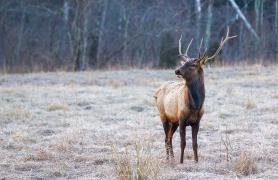Got a question for Ask MDC? Send it to AskMDC@mdc.mo.gov or call 573-522-4115, ext. 3848.
Q: What animal ate this deer? I’ve never seen an animal pluck the hair and eat the skin of a deer?
Probably a coyote. Usually when you find a carcass intact, one lone coyote has fed on it. When you find a carcass torn up, with pieces of hide and bone scattered around, several coyotes have had a meal. The alpha coyote feeds on the main carcass while younger and smaller coyotes run in and tear off pieces. The longer the carcass lays there, other scavengers, such as vultures and opossums, feed on the remains. Since hair lacks food value, it tends to get pulled out or scratched off.
Q: What happened to this tree?
This bark damage is related to emerald ash borer (EAB) infestation. It’s caused by woodpeckers pursuing insect larvae inside the ash trees, popping off pieces of bark as they forage. That lighter-colored inner bark is noticeable when freshly exposed, leading foresters to refer to the process as “blonding.”
Bark blonding on ash is directly related to insect infestation — the woodpeckers aren’t going to tear up a tree if there’s nothing inside to eat. Native borers can attack stressed ash trees, but only the unchecked populations of emerald ash borer larvae lead to woodpeckers blonding an entire tree or several in one area.
The good news is that EAB will only attack ash trees. The bad news is that trees with extensive bark blonding are past the point of being saved by insecticidal treatments. EAB-infested trees are brittle and potentially hazardous. If infested trees are near a home or other valuable property, it is important to remove them immediately. The infested wood can be utilized or burned at the homeowner’s discretion.
Within about five years, EAB will kill nearly every ash tree (sometimes younger, smaller trees escape death) in the vicinity, unless the nearby trees have genetic resistance. But that’s rare; only about one in 1,000 trees exhibit natural resistance.
If an ash tree seems relatively healthy as spring approaches, insecticide treatments in late April through May can be effective. For more information, visit short.mdc.mo.gov/ZtV.
Q: I ran across this unusual looking beehive on my farm in Gasconade County. Is this a normal beehive? What kind of bee constructed it?
These are European honeybee (Apis mellifera) combs. They typically seek out enclosed tree cavities, but this swarm appears to have taken up residence in the wrong spot, as far as winter survival goes. It’s uncommon, but not incredibly rare.
European settlers introduced the honeybee to North America hundreds of years ago, and wild populations occur throughout Missouri. The nest “comb” is suspended vertically and consists of parallel double-layered sheets of hexagonal cells. These are made from wax secreted by worker bees, who also use the nectar from flowers to produce honey in their stomachs. The bees thicken the honey by regurgitating it onto their mouths and exposing it to air. Honey and pollen stored in nest cells nourish the adult bees in winter. For more information on bees, visit short.mdc.mo.gov/Ztj.
Also In This Issue

Serving Nature and You: Fiscal Year July 1, 2020 – June 30, 2021
And More...
This Issue's Staff
Stephanie Thurber
EDITOR
Angie Daly Morfeld
ASSOCIATE EDITOR
Larry Archer
PHOTOGRAPHY EDITOR
Cliff White
STAFF WRITERS
Kristie Hilgedick
Joe Jerek
Dianne Van Dien
DESIGNERS
Shawn Carey
Marci Porter
PHOTOGRAPHERS
Noppadol Paothong
David Stonner
CIRCULATION MANAGER
Laura Scheuler






















